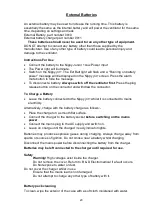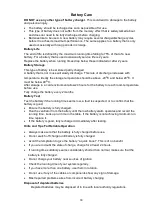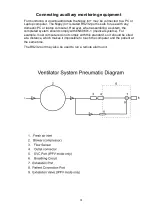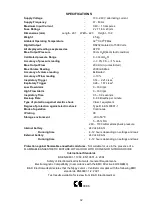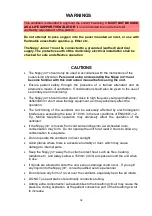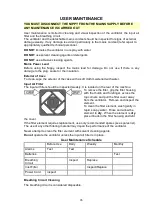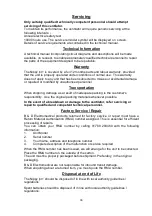
24
Setting Up the Alarms
Automatic Setting
For convenience, the high and low flow alarms may be set automatically. Varying
leak or the patient getting out of synch with the ventilator may disrupt the
measurement process. Therefore it is vital that the alarms are tested after setting up.
Low Flow Alarm
•
Press and hold the Low Flow Alarm button
•
The ventilator will read the peak flow, the inspiratory baseline or leak flow and set the
low flow alarm to the mid point between these two values.
•
This setting may be further adjusted manually if required.
•
Test the alarm as detailed in “Alarm Conditions and Tests” section of this
manual.
High Flow Alarm
•
Press and hold the High Flow Alarm button
•
The ventilator will read the peak flow and set the high flow alarm to this value plus
30% or 20 l/min, whichever is greater.
•
This setting may be further adjusted manually if required.
•
Test the alarm as detailed in “Alarm Conditions and Tests” section of this
manual.
Warning!
The auto set facility is not infallible. Varying leak can cause erroneous readings.
The settings must be verified and the alarm function tested.
If the alarm settings are not
correct or the alarms do not operate when tested, proceed to the manual set up.
Manual Setting
Low Flow Alarm:-
•
Note the peak flow reading. This is the patient’s peak inspiratory flow.
•
Disconnect the breathing circuit at the mask or tracheotomy and occlude the end (do
not obstruct the exhale port). Note the peak flow reading. This is the leak flow.
•
Reconnect the breathing circuit.
•
Set the Lo alarm to a value approximately half way between the leak flow and the
peak inspiratory flow.
•
Test the alarm as detailed in “Alarm Conditions and Tests” section of this
manual.
•
If the patient is being treated via a nasal mask, this alarm is not required and may be
set to minimum.
High Flow Alarm:-
•
Note the peak flow reading. This is the patient’s peak inspiratory flow.
•
Disconnect the breathing circuit at the mask or tracheotomy end. Note the peak flow
reading. This is the disconnected flow.
•
Set the Hi alarm to a value a little higher than the peak inspiratory flow. This must be
lower than the disconnected flow. Allow for an increase in flow if the patient takes a
deep breath.
•
Test the alarm as detailed in “Alarm Conditions and Tests” section of this
manual.




















